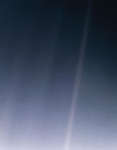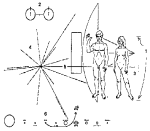
|
You entered: Carl Sagan
 Carl Sagan 1934-1996
Carl Sagan 1934-1996
25.12.1996
Carl Sagan died last Friday at the age of 62. Sagan was the world's most famous astronomer. Among his many activities as a scientist, he contributed to the discovery that the atmosphere...
 Wanderers
Wanderers
28.04.2018
How far out will humanity explore? If this video's fusion of real space imagery and fictional space visualizations is on the right track, then at least the Solar System. Some of the video...
 Wanderers
Wanderers
7.12.2014
How far out will humanity explore? If this video's fusion of real space imagery and fictional space visualizations is on the right track, then at least the Solar System. Some of the video...
 APOD: 2023 March 26 Б Wanderers
APOD: 2023 March 26 Б Wanderers
25.03.2023
How far out will humanity explore? If this video's fusion of real space imagery and fictional space visualizations is on the right track, then at least the Solar System. Some of the video...
 The Pale Blue Dot
The Pale Blue Dot
13.02.2020
On Valentine's Day in 1990, cruising four billion miles from the Sun, the Voyager 1 spacecraft looked back one last time to make the first ever Solar System family portrait. The portrait consists...
 A Martian Day's End
A Martian Day's End
6.07.1997
A Day or "Sol" on Mars is only 40 minutes longer than an Earth day - and Pathfinder's first day on Mars, Sol 1 according to its local calendar, was an eventful one. Still...
 Greetings from the Pioneers
Greetings from the Pioneers
30.06.1996
Launched in the early 1970s Pioneer 10 and 11 were appropriately named - becoming the first spacecraft to travel through the asteroid belt, first to fly by Jupiter and Saturn, and the first human artifacts to venture beyond the solar system.
 Ares 3 Landing Site: The Martian Revisited
Ares 3 Landing Site: The Martian Revisited
21.06.2019
This close-up from the Mars Reconnaissance Orbiter's HiRISE camera shows weathered craters and windblown deposits in southern Acidalia Planitia. A striking shade of blue in standard HiRISE image colors, to the human eye the area would probably look grey or a little reddish.
 Ares 3 Landing Site: The Martian Revisited
Ares 3 Landing Site: The Martian Revisited
22.03.2024
This close-up from the Mars Reconnaissance Orbiter's HiRISE camera shows weathered craters and windblown deposits in southern Acidalia Planitia. A striking shade of blue in standard HiRISE image colors, to the human eye the area would probably look grey or a little reddish.
 Ares 3 Landing Site: The Martian Revisited
Ares 3 Landing Site: The Martian Revisited
15.05.2015
This close-up from the Mars Reconnaissance Orbiter's HiRISE camera shows weathered craters and windblown deposits in southern Acidalia Planitia. A striking shade of blue in standard HiRISE image colors, to the human eye the area would probably look grey or a little reddish.
|
January February March April |
|||||||||||||||||||||||||||||||||||||||||||||||||